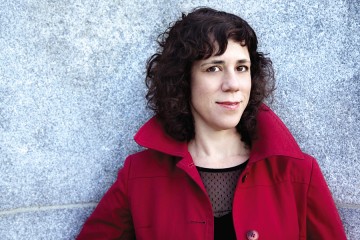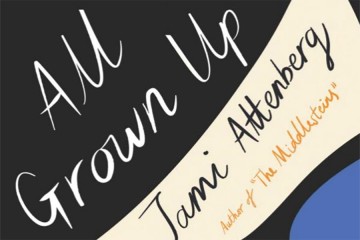"I love my writer friends," Jami Attenberg, A&S '93, tells me during a Zoom call in October.
This isn't news to the tens of thousands of people who regularly read her weekly "Craft Talk" Substack newsletter, nor to those who take to social media each year to publicly track their participation in #1000WordsofSummer, a writerly accountability project Attenberg and memoirist and fellow New Orleanian Susan Gisleson launched in the spring of 2018.
As Attenberg tells it, #1000WordsofSummer was inspired by an actor pal who'd participated in a rigorous boot camp while getting in shape for a part in a movie. Attenberg approached Gisleson with the idea of doing for their writing projects what this actor had done for his obliques.
Gisleson had a nonfiction proposal to write, while Attenberg was nearing the deadline to finish her seventh book. A creative binge seemed like just the way to hit those goals while setting the tone for a productive summer. The plan was manifestly simple: For two weeks, they'd commit to writing 1,000 words a day, and they'd check in with each other to make sure they were staying on track. There'd be no trading work and no judgment; just 1,000 words a day for two weeks.
Why two weeks, and why 1,000 words?
According to Attenberg, "A month felt like a job, and a week felt like not enough work would get done." As for the word count, well, the one follows the other. In a typical word processor with standard settings, 1,000 words is about four double-spaced pages, not so much work as to be a Sisyphean drag but significant enough that, after two weeks of getting to the desk consistently, a writer could crank out 56 pages, a respectable count for most writers I know.
The project would likely have remained a private challenge between friends had Attenberg not described the idea on Twitter. When she did, there was almost immediate interest from all sorts of writers, some known to her, most not. That first year, 2,000 people played along. More recently, the project saw some 30,000 participants.
Not unlike National Novel Writing Month, #1000WordsofSummer remains mostly a project about encouragement and accountability, but unlike NaNoWriMo—which incorporated as a 501(c)3 nonprofit in 2006 and now runs educational programs, accepts charitable contributions, and has a slick website and a robust accountability system—#1000WordsofSummer remains coolly ad hoc. There's no fee to participate, no minimum experience necessary, no account to create or manage, and there's loads of online encouragement should a writer want it.
The project has also spawned two offspring: the "Craft Talk" Substack and her new book, 1,000 Words: A Writer's Guide to Staying Creative, Focused, and Productive All Year Round, due out from Simon Element in January and the reason for my Zoom call.
It's Attenberg's first interview about 1,000 Words, she tells me, and I wanted to know how a writing challenge between friends grew into, well, all this. Attenberg takes a moment before responding. "It's a good question," she says. "If I'd planned it, it wouldn't have worked, you know?"

Image caption: Jami Attenberg
Image credit: Edmund Fountain
Readers of "Craft Talk" will recognize in this answer Attenberg's tendency to ascribe her own success to elbow grease and good fortune. They'll also recognize that the secret sauce of #1000Words is the same additive to "Craft Talk": Attenberg's generous observations, informed advice, and her belief that if a person feels called upon to write, they should probably heed the instinct.
In total, over 50 authors—Roxane Gay, Lauren Groff, Alexander Chee, Kiese Laymon, Susan Orlean, and Celeste Ng notably among them—contributed to 1,000 Words, and their thinking represents a grab bag of potential solutions to writing problems. But advice is only useful if a person can readily access it, and Attenberg avoids the obvious problem of the entries seeming scattershot by grouping them thematically.
Early in the book, she analogizes the stages of the writing process to the seasons. In her formulation, winter is a time of introspection and big-picture thinking. Spring is a time of planning and expectation. Summer is the time for action and diving headlong into a project. And fall is the time for reflection and for recognizing the hard work you've put in. While this organizing principle might seem a little cute at first, it makes the book easy to navigate and useful.
Laura van den Berg's essay about establishing routines appears in "Spring," for instance, where she recounts her transition from being the kind of writer who "never had a morning routine" into one who had to carve out writing time when her academic duties increased. "Maybe you can only do 30 minutes or maybe you can listen to a recording of a story you love while you walk the dog," she writes. "Here's the bottom line: I think often of what a painter said to me at a residency: 'Work makes more work.'"
By contrast, Benjamin Percy's entry appears in "Summer" and is about managing the messiness of being elbow-deep into a project. His advice is to write with an ending in mind. "I always know my endgame. Always," Percy writes. "If you know your end, even when you're starting from scratch, there is no blank page. The finish line is in sight—you just have to race to get there."
If 1,000 Words is a kind of DSM for our writerly problems, then this seasonal organizational strategy is the index.
It's worth mentioning here that the word "craft," as it applies to writing, is a slippery term, one that's not without controversy. For some writers, craft is all nuts-and-bolts stuff, akin to cabinetmaking or cake baking or gardening. Craft is about the materials, the tools, the process, and the finishing. For others, the very notion of creative writing pedagogy is suspicious because it privileges certain kinds of writing and advice. Think of the common notions that a writer shouldn't include dreams in fiction, or that they shouldn't kill a protagonist, or that they must create narrative tension that builds to a climactic moment. These aren't laws, of course, but they've become so customary in workshop environments that they might as well be. Craft notions can carry with them expectations that artificially shape—and hinder—our creative practices and the eventual critical reception.
Regardless, I've spent 20 years in the publishing industry and nearly as many teaching creative writing and composition, and in that time, I've developed a quick, binary taxonomy for understanding the general tack of a craft text, one based on where I would prefer to interact with the book, either on my couch or at my desk.
Couch books lean toward the theoretical and often approach writing and the teaching of writing from a bird's-eye view. John Gardner's The Art of Fiction, Charles Baxter's Burning Down the House, Felicia Rose Chavez's The Anti-Racist Writing Workshop, James Wood's How Fiction Works, and Matthew Salesses' Craft in the Real World are the sorts of texts I reach for when I want to spend time thinking about writing.
The desk books are those I want within arm's reach as I am writing. Some of these are technical (I kept a copy of the Practical English Handbook next to my computer throughout college), and some are more conversational.
Anne Lamott's Bird by Bird has been a veritable urtext in creative writing workshops since it was published nearly 30 years ago because its tone is casual and humorous, and its short, direct chapters invite writers of all levels of skill and experience to sit down and write. It is, most definitely, a desk book. Matt Bell's recent craft book, Refuse to Be Done, also falls into this category. 1,000 Words does, too. Like the Lamott and the Bell texts, it's meant to be thumbed through, dog-eared, and returned to. Its advice is to be applied as needed.
Because Attenberg's own entries appear throughout the book, it's her authorial voice that makes 1,000 Words feel cohesive. Her pieces of writerly advice (perhaps best understood as encouragements) are presented under simple headings, such as "When to Write About Something Personal," "Reading Your Work Out Loud," and "Giving Criticism." Sometimes, she's the parent sitting in the stands shouting your name and rooting for you, and at others, she's the football coach standing on the sidelines, dishing out tough love.
In a section titled "What Are You Waiting For?" Attenberg asks, "What if you went your whole life without knowing if you could have done this? Are you letting this aspect of yourself—your creative goals—pass you by?"
I shudder at the thought.
I reached out to various contributors to the book and asked about their own creative practices. I'd read their essays in 1,000 Words, so I had a good idea of where, for example, Benjamin Percy stood on writing with an ending in mind, but I wanted to know if the incremental practice encouraged by #1000WordsofSummer really worked for him.
"I base my progress on the hours spent at the desk," he tells me. "Everyone has their own gauge for a good day's work. Because I'm often researching or outlining or interviewing or approving art or pitching over Zoom or editing a script or story, for me a successful increment is the time spent in concentration." What's a word count for Attenberg is measured in minutes and hours for Percy, but the principle is roughly the same: The work comes incrementally, but it only comes if you make space and time for it. Neither Percy nor Attenberg is sitting around waiting for the muse.
Nor is Carmen Maria Machado, whose entry in 1,000 Words expands the definition of creative work to include all the thinking, obsessing, and perseverating a writer does, and reminds readers to record the observations and discoveries they make while they're indulging in their obsessions, even if they don't yet know how they'll use the information. She told me that her current fixations include centos—poems built entirely of lines by other poets—haunted houses, and the painter Remedios Varo.
Memoirist and contributor Isaac Fitzgerald credits the success of #1000WordsofSummer to its iterative nature. "My apartment is never cleaner, my calendar never more up-to-date, and my closet never more organized by varying degrees of shirt color than when I am on deadline. But when I force myself, day after day, to make some time for the work—what a surprise! The work begins to get done. #1000WordsofSummer makes you carve out that time."
If there's a common thread that ties the essays in Attenberg's book to the interviews I conducted with its contributors, it's this: Routines are necessary for the completion of a writing project.
"I believe so much in the power of accumulated effort and imagination over time," Laura van den Berg told me. "And I'm not sure how that accumulation happens without some kind of practice in place. The shape can vary wildly from writer to writer, of course, but for me practice is not only a physical act but a kind of mental space that I enter. No matter how well the work is—or is not—going, I enter into that space because that's part of what I am here to do. I think a commitment to practice is a belief in the possibility of transformation over time. It is a hopeful act."
In the book and during my interview with Attenberg, the idea of hope crops up multiple times, and at first I'm not sure what to make of it. After all, participation in #1000WordsofSummer ballooned during the COVID-19 pandemic, a time that felt particularly hopeless to so many.
Were people taking advantage of the time that'd been freed up when long commutes and hours in the office evaporated? Were people participating out of boredom? Were they distracting themselves from the awful, daily death tolls?
Attenberg can't say with certainty that #1000WordsofSummer expanded as rapidly as it did as a result of COVID, but she does say that the pandemic motivated her to keep the project going. She tells me that, during the depths of the lockdowns, she "had friends in New York who were like, I'm trapped in this apartment and I can't go anywhere or do anything!" In New Orleans, at least she could spend time in her yard.
"I was like, how do I help? I mean, I'm writing my book, and then I'm done by noon every day. Where was I supposed to put all of my energy? I'd started the newsletter because, I thought, I have all this information that I can share with people. Maybe it won't change their lives, but if it inspires them to write or makes them feel like they can write, then that's a good thing that I did with my time that week."
When I ask if that desire to instill hope in others is part of the reason why she ultimately decided to publish a craft book, she's quick to remind me that "the name of the newsletter is 'Craft Talk,' but it's ironic because I don't really give craft talks. I just talk about things that I'm interested in. I'm in awe of people who can give fancy, high-minded, intellectual craft talks, but it's just not what I do."
Also see
I note that 1,000 Words is, in fact, chock-full of her very good observations about writing, language, and the nature of work, and Attenberg concedes the point, sort of. "I mean, I'm intellectual and an artist, and I feel like I write complicated, nuanced, challenging work, but when I'm talking to people about writing, my goal is to make people feel encouraged and excited. I don't know that all craft books are so welcoming, and I want people to feel really welcome. I want them to feel free and happy and encouraged and invited."
In a publishing ecosystem that rewards very few writers with significant money, accolades, positive reviews, and the minor sort of fame accorded to big-name writers, Attenberg's basic assumptions—that writing is a worthwhile pursuit and that people who are drawn to write should be encouraged and empowered to do so—may seem naive. It's hard out there, and tending to the thoughts, needs, and desires of other writers has the potential to drain energy and time from your own work. How can we writers get our own work done while also encouraging others?
It seems to be a high bar to write your own books (she's got two on deck as of this writing) while also running a project like this one and putting out a regular Substack and working to make other writers feel included and enthused about their work. Near the end of our chat, I try to be sensitive when I ask if it's too much, too heavy a lift. "What else are we supposed to be doing with our time?" she asks me. "There's always room to be good to people."
Posted in Arts+Culture, Alumni













